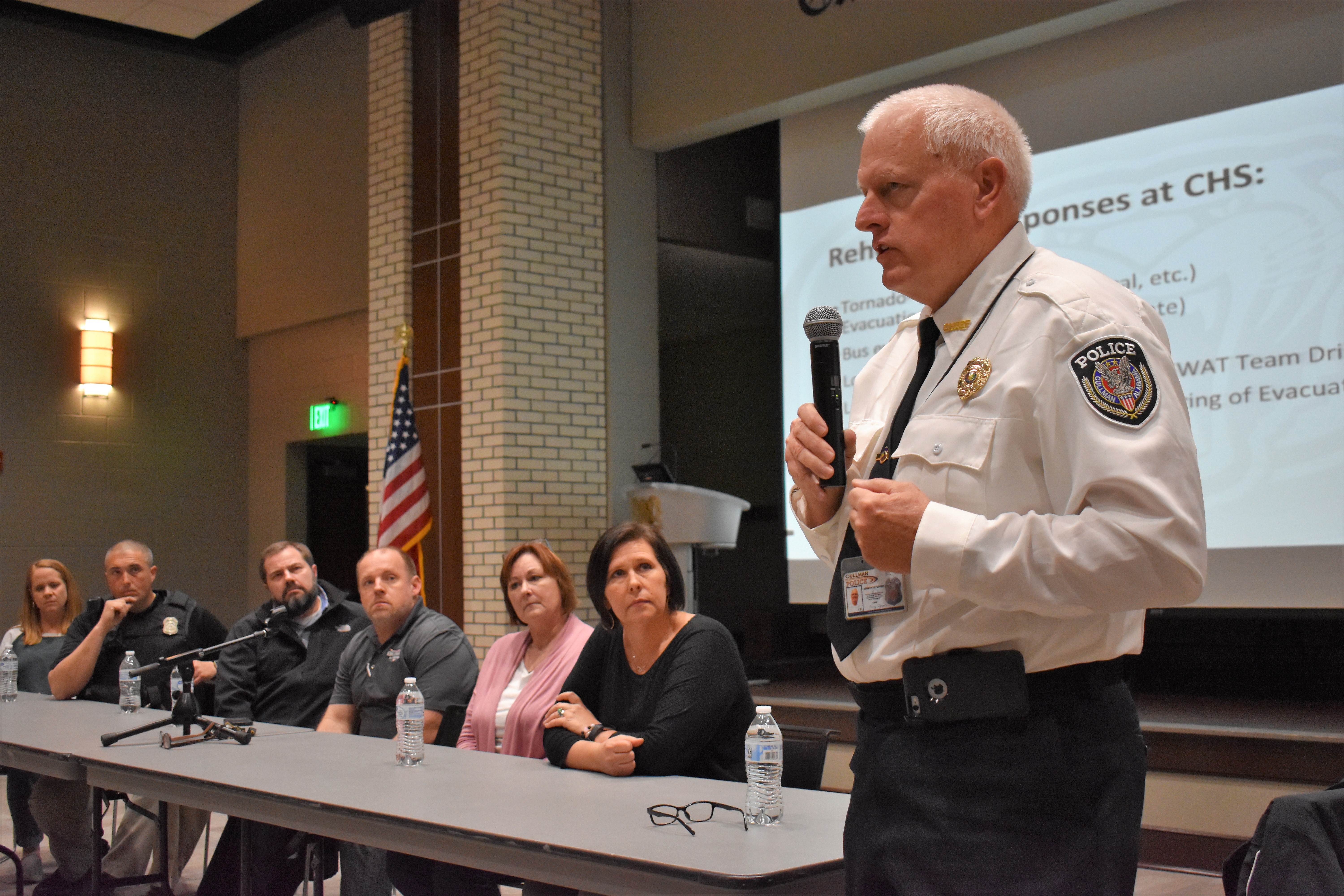Panelists listen as Cullman Police Chief Kenny Culpepper talks about police response procedures. L-R Joey Orr, John Anderson, Jason Neal, Chris Branham, Gail Swafford and Kay Bell / W.C. Mann
CULLMAN – In the wake of the recent tragic school shooting in Florida, and following threats against Cullman area schools (which, fortunately, turned out to be hoaxes, though they did lead to city schools spending a day on “soft lockdown”), several Cullman parents expressed concern about Cullman High School’s (CHS) safety and security procedures. On Monday evening, Principal Kim Hall hosted a panel presentation to explain those measures to interested parents, and to introduce them to some of the people responsible for their children’s safety at school.
The “Safety Summit” panel consisted of CHS Principal Kim Hall, CHS Assistant Principal Aaron Sparks, Cullman Police Department (CPD) Chief Kenny Culpepper, CHS Resource Officer John Anderson, Juvenile Probation Director Kay Bell, Child Advocacy Center/Brooks’ Place Executive Director Gail Swafford, and Cullman City School Board members Chris Branham, Jason Neal and Joey Orr.
Hall spoke with The Tribune about the purpose of the meeting. “We decided that, after the recent events, that parents had a lot of questions about how we handle different safety situations. And, although we as a school and a faculty and the various community agencies, we work very closely together, we found that maybe some parents didn’t know what our procedures were or didn’t understand some of the terminology that we were using.
“So, we decided to come together with the school, and with some of the various agencies to share that information and also to make known our relationship with the CPD, Cullman Fire Rescue (and Cullman) EMS. And then we also have Brooks’ Place Child Advocacy and (the) Juvenile Probation Office, as well. You know, just some questions that we can answer for parents about how we handle different issues that may arise on campus.”
Continued Hall, “We actually have a very close relationship with the emergency agencies in town. As a matter of fact, any time that we have an issue arise of any type, whether we may smell gas on campus and we want somebody to come check it out; we’ve got the fire department available, we have Cullman Jefferson Gas. Any kind of issue that we may have, as far as weather, we have a close relationship with the (Cullman County) Emergency Management Agency.”
Hall and Sparks talked about the school’s Crisis Response Plan, an Alabama State Department of Education requirement for all schools. They discussed the Virtual Alabama Portal, which makes school maps and key staff contact information immediately available to police and emergency responders, allowing them to navigate the campus and communicate with the administration in the midst of a crisis. They also noted the school’s use of regular safety drills to ensure students and faculty are familiar with emergency procedures.
Hall also showed parents a list of all personnel on the school’s Crisis Management Team, including herself, Sparks, Culpepper, Anderson, Bell, Swafford and:
- Cullman City Schools Superintendent Dr. Susan Patterson
- CHS Assistant Principal Mark Stephens
- CHS Assistant Principal Jake Johnson
- Cullman City Schools Safety Coordinator Tommy Duke
- CPD Day Shift Capt. Bobby Kelly
- Cullman EMA Director Phyllis Little
- Cullman Fire Chief Edward Reinhardt
- Wellstone Behavioral Health CEO Chris Van Dyke
Hall and Sparks talked about safety upgrades at CHS facilities, including expanded use of security cameras (the school currently has more than 100) linked to large screen monitors in the offices of administrators, installation of new security fencing to limit campus access points, the securing of outer doors and installation of a buzz-in system on the main doors.
Hall and Culpepper talked about lockdown procedures, helping parents understand what happens during such an event, and the difference between “soft” and “hard” lockdowns:
Soft Lockdown
- Used in response to potential threats to the school or near the school
- All exterior doors locked
- Teachers keep classroom doors locked
- Increased teacher presence in the halls
- Student traffic in hallways avoided unless necessary
- Students not allowed to go to the parking lot
- Students and teachers to report suspicious activity to the administration immediately
- Administration and law enforcement will patrol the campus
- Updates and announcements via PA, email, phone, text, etc.
- No phone or email checkouts, to avoid unattended students in parking lots
Hard Lockdown
- Used in response to immediate threats from intruders, hostage situations or disorderly student conduct
- If the principal determines that a security threat exists, law enforcement will be contacted immediately.
- Exterior doors will be locked and will not be opened to the public for any reason until conditions are determined to be safe and the lockdown is lifted.
- Due to their lockdown locations on the campus, a good chance exists that office staff and administrators will not be able to answer phone calls or see incoming emails.
- Parents/guardians attempting to check students out must comply with school officials and law enforcement.
Sparks, Anderson and Culpepper briefly addressed the ALICE program for responding to active shooter situations:
A – Alert, recognizing quickly what is happening
L – Lockdown, barricading to limit room access until evacuation or other response
I – Inform, communicating the shooter’s location and direction, if possible
C – Counter, creating noise, movement, distance, and distraction to limit the shooter’s ability to shoot accurately
E – Evacuate, getting out of harm’s way when a path is clear
Before an informal question and answer session Hall finished the presentation by listing the ways CHS parents can receive emergency communications:
- Follow CHS Twitter: @Cullmancats
- Follow CHS Instagram: cullmanhighschool
- The Cullman City Schools app, available from Apple or Google Play
- Blackboard Messenger
“One thing I think we want to make clear,” Hall told The Tribune, “is that we do work very closely with our police department (and) emergency management. They review our plans, they work with us. They do walk-throughs at our school to make sure that they’re familiar with our facilities, to make sure that our students and our faculty and visitors are safe at all times.
“And then we’re also working very closely with our Cullman City Board of Education and the system-wide maintenance staff to make some adjustments on campus, to make it a little bit more secure for our students and our teachers.
“We have a great partnership in our community. We’re very blessed to have so many people willing to invest in our students, not only their educational opportunities, but their safety, as well."
Copyright 2018 Humble Roots, LLC. All Rights Reserved.




























